Abstract
Data from ambulatory electrocardiographic recording in 35 highly trained endurance athletes and in 35 non-athletic controls of similar ages are given. The minimal, mean hourly, and maximal heart rates were significantly lower in the athletes. Thirteen athletes (37 . 1%) but only two controls (5 . 7%) had sinus pauses exceeding 2 . 0 seconds. First degree atrioventricular block was observed in 13 athletes (37 . 1%) and five controls (14 . 3%), second degree Wenckebach type block in eight athletes (22 . 9%) and two controls (5 . 7%), and second degree block with Mobitz II-like pattern in three athletes (8 . 6%) and no control. All athletes with Mobitz II-type pattern also had first degree and Wenckebach-type second degree atrioventricular block. The behavior of sinus rate on development of atrioventricular block varied, not only interindividually but also intraindividually, from absence of change to an increase or decrease in most subjects in both study groups. A decrease in sinus rate on appearance of atrioventricular block was found constantly in only two athletes and one control. Atrioventricular dissociation with junctional rhythm occurred in seven athletes (20%) and with ventricular rhythm in one athlete. Neither of these phenomena was seen in the group of controls. The athletes had slightly fewer ventricular extrasystoles than controls, and no athlete had ventricular tachycardia, whereas two controls had ventricular tachycardia.
Full text
PDF
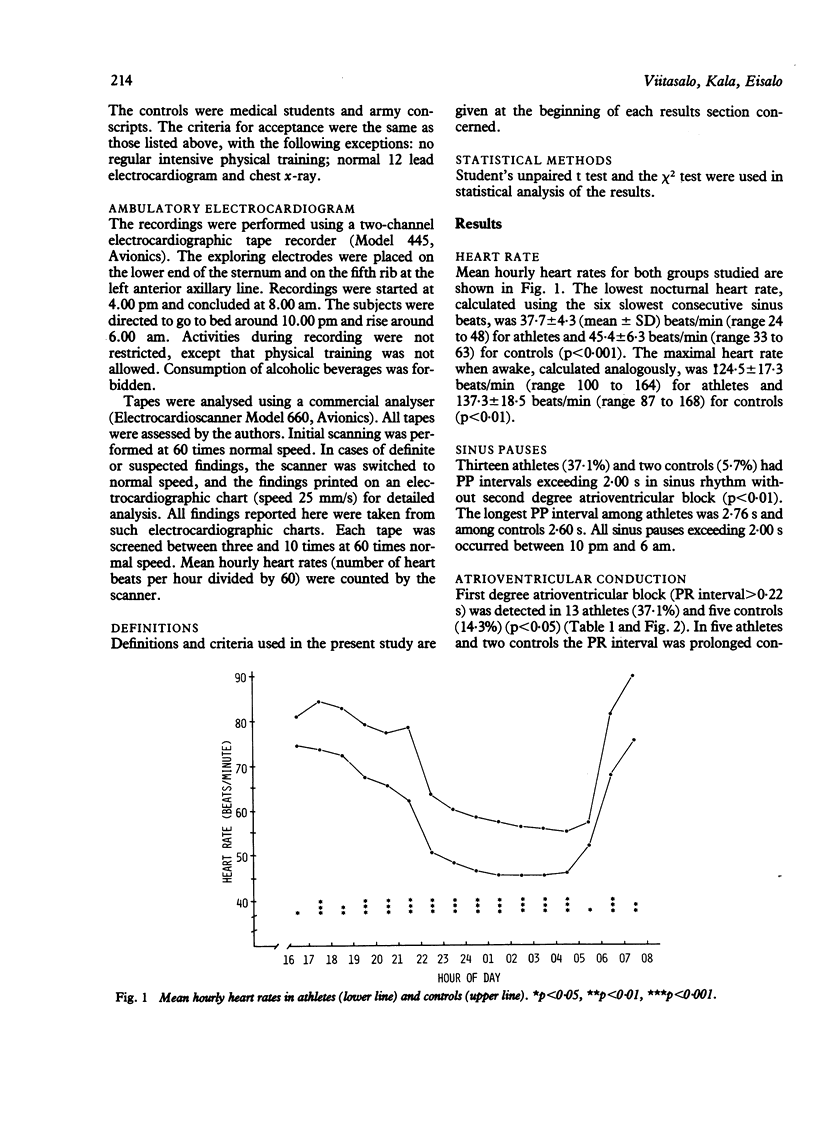
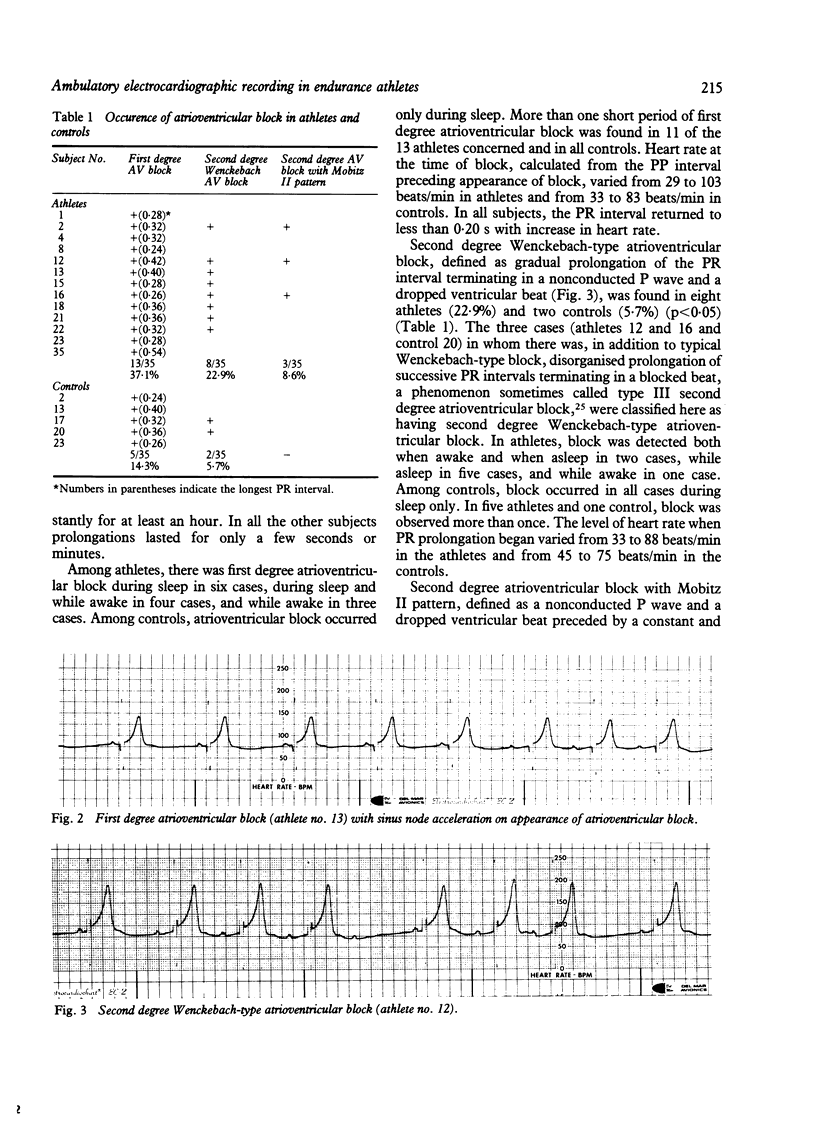

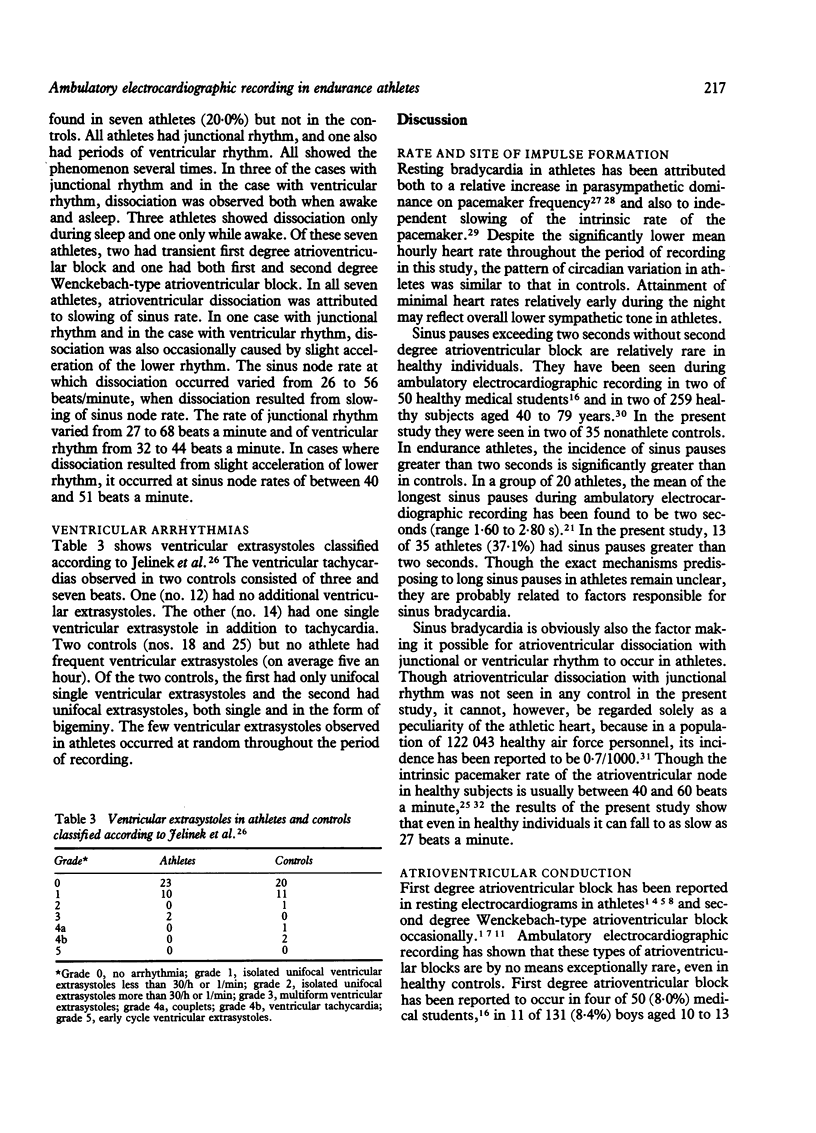
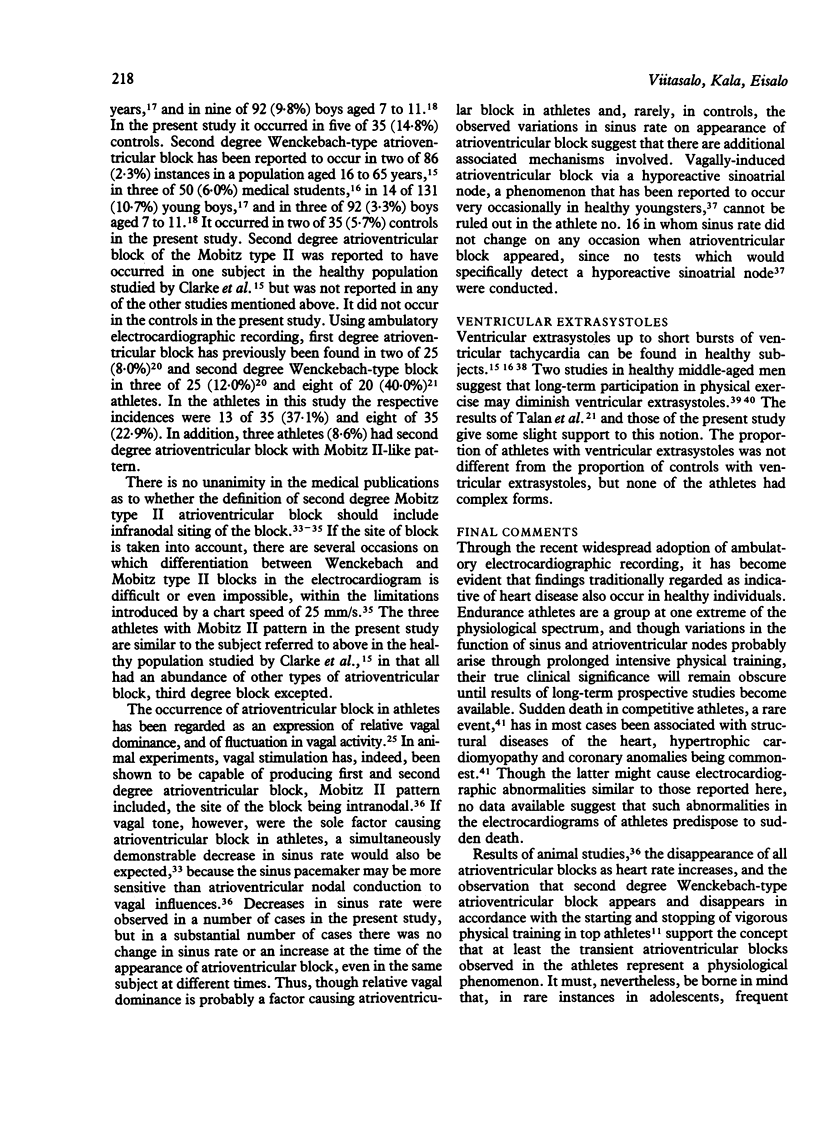

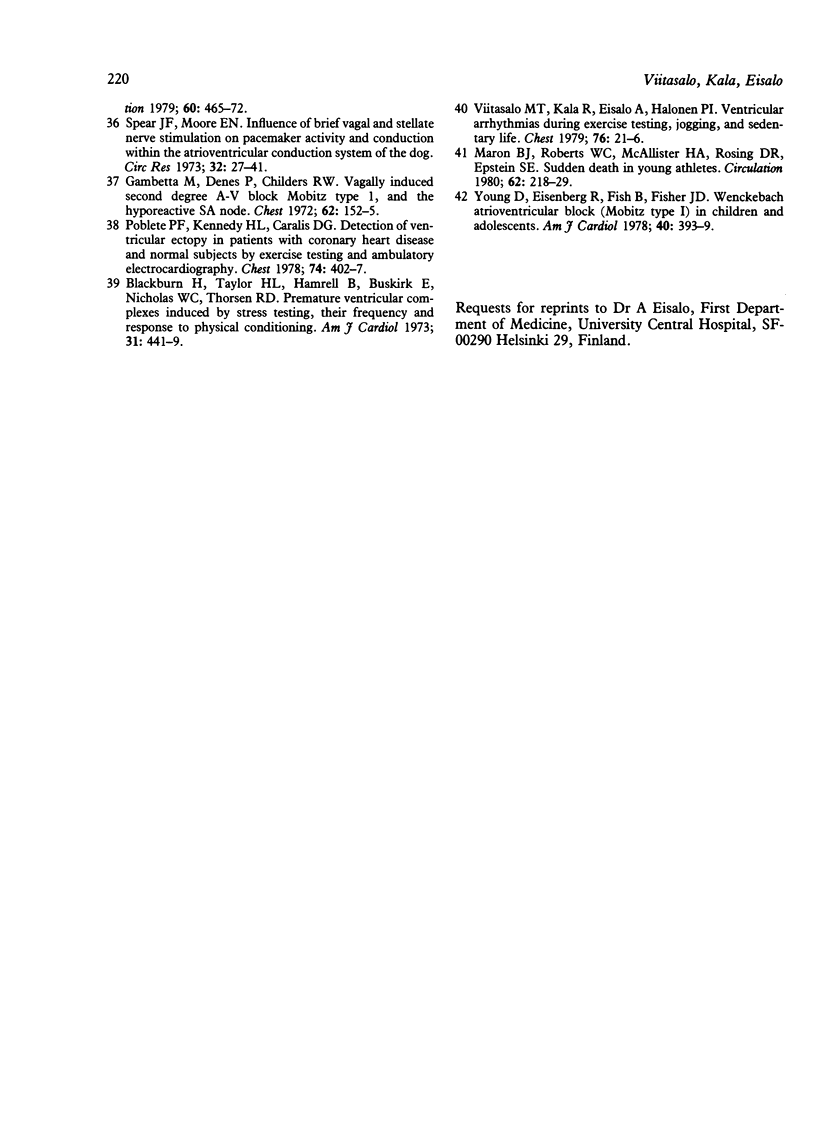
Selected References
These references are in PubMed. This may not be the complete list of references from this article.
- BECKNER G. L., WINSOR T. Cardiovascular adaptations to prolonged physical effort. Circulation. 1954 Jun;9(6):835–846. doi: 10.1161/01.cir.9.6.835. [DOI] [PubMed] [Google Scholar]
- Badeer H. S. Resting bradycardia of exercise training: a concept based on currently available data. Recent Adv Stud Cardiac Struct Metab. 1975;10:553–560. [PubMed] [Google Scholar]
- Blackburn H., Taylor H. L., Hamrell B., Buskirk E., Nicholas W. C., Thorsen R. D. Premature ventricular complexes induced by stress testing. Their frequency and response to physical conditioning. Am J Cardiol. 1973 Apr;31(4):441–449. doi: 10.1016/0002-9149(73)90292-0. [DOI] [PubMed] [Google Scholar]
- Brodsky M., Wu D., Denes P., Kanakis C., Rosen K. M. Arrhythmias documented by 24 hour continuous electrocardiographic monitoring in 50 male medical students without apparent heart disease. Am J Cardiol. 1977 Mar;39(3):390–395. doi: 10.1016/s0002-9149(77)80094-5. [DOI] [PubMed] [Google Scholar]
- Clarke J. M., Hamer J., Shelton J. R., Taylor S., Venning G. R. The rhythm of the normal human heart. Lancet. 1976 Sep 4;1(7984):508–512. doi: 10.1016/s0140-6736(76)90801-1. [DOI] [PubMed] [Google Scholar]
- Ekblom B., Kilbom A., Soltysiak J. Physical training, bradycardia, and autonomic nervous system. Scand J Clin Lab Invest. 1973 Nov;32(3):251–256. doi: 10.3109/00365517309082468. [DOI] [PubMed] [Google Scholar]
- Frick M. H., Elovainio R. O., Somer T. The mechanism of bradycardia evoked by physical training. Cardiologia. 1967;51(1):46–54. doi: 10.1159/000165849. [DOI] [PubMed] [Google Scholar]
- Frick M. H. Long-term excess physical activity and central haemodynamics in man. Adv Cardiol. 1976;18(0):136–143. doi: 10.1159/000399519. [DOI] [PubMed] [Google Scholar]
- Gambetta M., Denes P., Childers R. W. Vagally induced second degree A-V block Mobitz type I, and the hyporeactive SA node. Chest. 1972 Aug;62(2):152–155. doi: 10.1378/chest.62.2.152. [DOI] [PubMed] [Google Scholar]
- HISS R. G., LAMB L. E. Electrocardiographic findings in 122,043 individuals. Circulation. 1962 Jun;25:947–961. doi: 10.1161/01.cir.25.6.947. [DOI] [PubMed] [Google Scholar]
- HUNT E. A. Electrocardiographic study of 20 champion swimmers before and after 110-yard sprint swimming competition. Can Med Assoc J. 1963 Jun 22;88:1251–1253. [PMC free article] [PubMed] [Google Scholar]
- Hanne-Paparo N., Drory Y., Schoenfeld Y., Shapira Y., Kellermann J. J. Common ECG changes in athletes. Cardiology. 1976;61(4):267–278. doi: 10.1159/000169770. [DOI] [PubMed] [Google Scholar]
- Hanne-Paparo N., Wendkos M. H., Brunner D. T wave abnormalities in the electrocardiograms of top-ranking athletes without demonstrable organic heart disease. Am Heart J. 1971 Jun;81(6):743–747. doi: 10.1016/0002-8703(71)90078-0. [DOI] [PubMed] [Google Scholar]
- Häntzschel K., Dohrn K. The electrocardiogram before and after a marathon-race. J Sports Med Phys Fitness. 1966 Mar;6(1):28–32. [PubMed] [Google Scholar]
- Ikäheimo M. J., Palatsi I. J., Takkunen J. T. Noninvasive evaluation of the athletic heart: sprinters versus endurance runners. Am J Cardiol. 1979 Jul;44(1):24–30. doi: 10.1016/0002-9149(79)90246-7. [DOI] [PubMed] [Google Scholar]
- Jelinek M. V., Lohrbauer L., Lown B. Antiarrhythmic drug therapy for sporadic ventricular ectopic arrhythmias. Circulation. 1974 Apr;49(4):659–666. doi: 10.1161/01.cir.49.4.659. [DOI] [PubMed] [Google Scholar]
- Lichtman J., O'Rourke R. A., Klein A., Karliner J. S. Electrocardiogram of the athlete. Alterations simulating those of organic heart disease. Arch Intern Med. 1973 Nov;132(5):763–770. [PubMed] [Google Scholar]
- Maron B. J., Roberts W. C., McAllister H. A., Rosing D. R., Epstein S. E. Sudden death in young athletes. Circulation. 1980 Aug;62(2):218–229. doi: 10.1161/01.cir.62.2.218. [DOI] [PubMed] [Google Scholar]
- Massie B., Scheinman M. M., Peters R., Desai J., Hirschfeld D., O'Young J. Clinical and electrophysiologic findings in patients with paroxysmal slowing of the sinus rate and apparent Mobitz type II atrioventricular block. Circulation. 1978 Aug;58(2):305–314. doi: 10.1161/01.cir.58.2.305. [DOI] [PubMed] [Google Scholar]
- Meytes I., Kaplinsky E., Yahini J. H., Hanne-Paparo N., Neufeld H. N. Wenckebach A-V block: a frequent feature following heavy physical training. Am Heart J. 1975 Oct;90(4):426–430. doi: 10.1016/0002-8703(75)90421-4. [DOI] [PubMed] [Google Scholar]
- Nakamoto K. Electrocardiograms of 25 marathon runners before and after 100 meter dash. Jpn Circ J. 1969 Feb;33(2):105–128. doi: 10.1253/jcj.33.105. [DOI] [PubMed] [Google Scholar]
- Parker B. M., Londeree B. R., Cupp G. V., Dubiel J. P. The noninvasive cardiac evaluation of long-distance runners. Chest. 1978 Mar;73(3):376–381. doi: 10.1378/chest.73.3.376. [DOI] [PubMed] [Google Scholar]
- Poblete P. F., Kennedy H. L., Caralis D. G. Detection of ventricular ectopy in patients with coronary heart disease and normal subjects by exercise testing and ambulatory electrocardiography. Chest. 1978 Oct;74(4):402–407. doi: 10.1378/chest.74.4.402. [DOI] [PubMed] [Google Scholar]
- Raskoff W. J., Goldman S., Cohn K. The "athletic heart". Prevalence and physiological significance of left ventricular enlargement in distance runners. JAMA. 1976 Jul 12;236(2):158–162. doi: 10.1001/jama.236.2.158. [DOI] [PubMed] [Google Scholar]
- Rosen K. M., Gunnar R. M., Rahimtoola S. H. Site and type of second degree A-V block. Chest. 1972 Feb;61(2):99–100. doi: 10.1378/chest.61.2.99. [DOI] [PubMed] [Google Scholar]
- SMITH W. G., CULLEN K. J., THORBURN I. O. ELECTROCARDIOGRAMS OF MARATHON RUNNERS IN 1962 COMMONWEALTH GAMES. Br Heart J. 1964 Jul;26:469–476. doi: 10.1136/hrt.26.4.469. [DOI] [PMC free article] [PubMed] [Google Scholar]
- Scott O., Williams G. J., Fiddler G. I. Results of 24 hour ambulatory monitoring of electrocardiogram in 131 healthy boys aged 10 to 13 years. Br Heart J. 1980 Sep;44(3):304–308. doi: 10.1136/hrt.44.3.304. [DOI] [PMC free article] [PubMed] [Google Scholar]
- Southall D. P., Johnston F., Shinebourne E. A., Johnston P. G. 24-hour electrocardiographic study of heart rate and rhythm patterns in population of healthy children. Br Heart J. 1981 Mar;45(3):281–291. doi: 10.1136/hrt.45.3.281. [DOI] [PMC free article] [PubMed] [Google Scholar]
- Spear J. F., Moore E. N. Influence of brief vagal and stellate nerve stimulation on pacemaker activity and conduction within the atrioventricular conduction system of the dog. Circ Res. 1973 Jan;32(1):27–41. doi: 10.1161/01.res.32.1.27. [DOI] [PubMed] [Google Scholar]
- VENERANDO A., RULLI V. FREQUENCY MORPHOLOGY AND MEANING OF THE ELECTROCARDIOGRAPHIC ANOMALIES FOUND IN OLYMPIC MARATHON RUNNERS AND WALKERS. J Sports Med Phys Fitness. 1964 Sep;4:135–141. [PubMed] [Google Scholar]
- Van Ganse W., Versee L., Eylenbosch W., Vuylsteek K. The electrocardiogram of athletes. Comparison with untrained subjects. Br Heart J. 1970 Mar;32(2):160–164. doi: 10.1136/hrt.32.2.160. [DOI] [PMC free article] [PubMed] [Google Scholar]
- Viitasalo M. T., Kala R., Eisalo A., Halonen P. I. Ventricular arrhythmias during exercise testing, jogging, and sedentary life: a comparative study of healthy physically active men, healthy sedentary men, and men with previous myocardial infarction. Chest. 1979 Jul;76(1):21–26. doi: 10.1378/chest.76.1.21. [DOI] [PubMed] [Google Scholar]
- Young D., Eisenberg R., Fish B., Fisher J. D. Wenckebach atrioventricular block (Mobitz type I) in children and adolescents. Am J Cardiol. 1977 Sep;40(3):393–399. doi: 10.1016/0002-9149(77)90161-8. [DOI] [PubMed] [Google Scholar]
- Zeppilli P., Pirrami M. M., Sassara M., Fenici R. T wave abnormalities in top-ranking athletes: effects of isoproterenol, atropine, and physical exercise. Am Heart J. 1980 Aug;100(2):213–222. doi: 10.1016/0002-8703(80)90117-9. [DOI] [PubMed] [Google Scholar]


